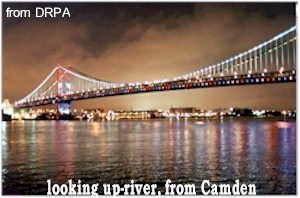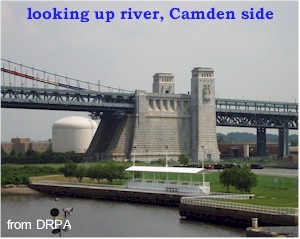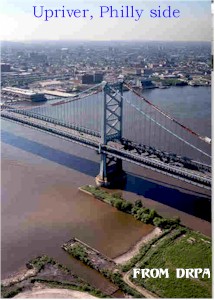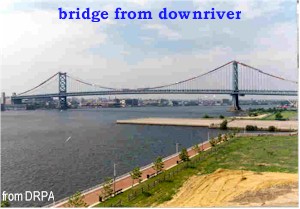The Ben Franklin
Bridge -
opened
July 1, 1926
 A
hundred years of talk had ended. Thirty-seven million dollars had been spent.
Thousands of workmen had toiled, and 14 had died. Now more than 763 tons of
concrete steel and stone miraculous - and gracefully spanned the Delaware
River.
A
hundred years of talk had ended. Thirty-seven million dollars had been spent.
Thousands of workmen had toiled, and 14 had died. Now more than 763 tons of
concrete steel and stone miraculous - and gracefully spanned the Delaware
River.
It was July 1, 1926, that the world's longest suspension bridge opened connecting Philadelphia and Camden. That historic day will be celebrated with a 75th anniversary re-enactment of the opening of the Benjamin Franklin Bridge on Sunday, June 30.
Back then, the mayors and governors had made their speeches, ribbons were cut and two little girls - the 10-year-old and 12-year-old daughters of Pennsylvania state treasurer Samuel S. Lewis - led a throng of pedestrians from Philadelphia onto the bridge while the 4-year-old daughter of bridge commissioner John F. Boyle led an excited crowd from Camden.
Cars were banned from 1 P.M. to 7 P.M., as an estimated 100,000 walkers strolled the engineering marvel known then as the Delaware River Bridge. At midnight, excited motorists formed long lines on both sides to cross the marvelous span at 25 cents each way. Drivers and passengers in 32,000 vehicles would brag that they had crossed the bridge during its first 24 hours of operation, Lured by the novelty of it all, some crossed and re-crossed the new bridge many times. Engineers have called the Ben Franklin "the pioneer of all big suspension bridges" and "the world's first modern suspension bridge."
 It put scores of
Delaware River ferryboats out of business. It still has graceful
"modern" lines, and it still handles a huge load of traffic, with 18
million vehicles crossing from New Jersey into Pennsylvania on it last year.
It put scores of
Delaware River ferryboats out of business. It still has graceful
"modern" lines, and it still handles a huge load of traffic, with 18
million vehicles crossing from New Jersey into Pennsylvania on it last year.
"Of all our facilities, the Ben is the jewel in the crown," said Joe Diemer, spokesman for the Delaware River Port Authority, which operates the Ben Franklin and its three sister bridges, the Walt Whitman, Betsy Ross and Commodore Barry bridges. "The others are very utilitarian and do a good job they do exactly what they were designed to do.
"But the Ben has a grace to it, an emotional appeal. There's a lot of majesty to it."
The seeds for the brim were planted in the 19th century, when local residents, mainly farmers looking to get their produce from the farms of southern New Jersey over to markets in Philadelphia, began looking for easy ways to get across the river.
"There are records that indicate that people in this region talked about some way to span the Delaware River all the way back to the 1800s," Diemer said. "There was talk, but, of course, they lacked any kind of technology to do that."
As early as 1818, there was talk about a footbridge from Camden to Windmill Island in the middle of the river (the island was totally removed by 1890), and perhaps a drawbridge to Philadelphia. There were many proposals over the decades, but nothing happened.
 Besides the
needs of farmers, the popularity of the automobile and the desire to escape
Philadelphia's summer heat and humidity to cottages in the countryside of New
Jersey made a bridge imperative in the 1920s. Cars waited at ferry crossings
for hours. One hot summer weekend in 1924, a 12-mile backup of cars waited for
ferries to take them from New Jersey to Philadelphia.
Besides the
needs of farmers, the popularity of the automobile and the desire to escape
Philadelphia's summer heat and humidity to cottages in the countryside of New
Jersey made a bridge imperative in the 1920s. Cars waited at ferry crossings
for hours. One hot summer weekend in 1924, a 12-mile backup of cars waited for
ferries to take them from New Jersey to Philadelphia.
"As the region grew, Philadelphians wanted to come to [the South Jersey] side to come to the shore and to resort communities on the Delaware River," Diemer said. "There was a lot of movement going back and forth."
There would be countless studies and false starts before a bi-state agreement was hammered out, and work started on the bridge in January 1922. Instead of a symbolic shovel of earth, two governors and two mayors removed planks from a pier to be demolished on the Philadelphia side.
Five riverfront sites had been studied from Spring Garden to Lombard streets. Franklin Square was selected, in part, because the bedrock under the river at this point was best for the bridge.
While a number of engineers and architects participated in the big project, the man given the lion's share of credit for the bridge's success was mild-mannered Polish-born chief engineer Ralph Modjeski. At the time, he was considered the leading bridge designer in the country.
Half of the costs of bridge construction would be paid by New Jersey, which tied the project to a bond issue for the Holland Tunnel. Pennsylvania and Philadelphia would each pay a quarter of the costs. It was agreed that all construction materials would be American-made.
"It was really a marvel at its time," Diemer said. "People were really amazed, especially the people who saw it built."
The first major step in construction was sinking two huge airtight, pressurized boxes called caissons. Inside the caissons, "sand hogs" with picks and shovels removed about 20 feet of sand and mud from the river bottom to hit bedrock.
The caissons then became molds filled with tons of concrete to create the piers that support the high steel towers that carry the bridge cables.
The bridge is 1.8 miles long, but that's not what made it the longest suspension bridge in the world in 1926. It was the 1,750 feet of cable between the two supporting towers that count in this competition. Both steel towers rise 380 feet above the water line.
Creating the cables involved stringing 18,666 wires - one at a time - from one side of the bridge to the other using a pulley device. The wires are not woven together. They are bundled into strands (306 wires per strand). All that wiring from end-to-end would stretch more than 25,000 miles.
At the height of construction, some 1,300 men labored on the bridge. They worked without safety nets. And in one tragic, three-month period in 1925, 10 workers were killed. Most died in falls.
 There were two
brief strikes. Forty-one unskilled concrete workers were fired and replaced
after demanding a raise from 40 cents to 50 cents an hour. Skilled ironworkers
struck briefly in an unsuccessful attempt to bring their hourly wage up from
$1.10 an hour to $1.25.
There were two
brief strikes. Forty-one unskilled concrete workers were fired and replaced
after demanding a raise from 40 cents to 50 cents an hour. Skilled ironworkers
struck briefly in an unsuccessful attempt to bring their hourly wage up from
$1.10 an hour to $1.25.
Modjeski predicted that the bridge would be completed in time for July 4,1926, when Philadelphia would be celebrating the nation's 150th birthday with a huge Sesquicentennial Exposition.
He was right on target, and it was decided to open the bridge three days early in order to accommodate the Independence Day weekend rush. President Calvin Coolidge showed up to plant a tree (which is still growing) on the Camden side on July 5.
The 25-cent, one-way toll for autos was not increased to 50 cents until 1968. Horse and wagons were still commonplace in 1926, so there were tolls for wagons, horse and rider and for leading livestock across the bridge on foot. Animals were later banned, but records for 1927 show 102 people galloped across the span on horseback, 79 farm animals were led across and about 1,400 horse and wagons also crossed.
For a while, there was no speed limit on the bridge or overhead red and green lights showing direction for auto lanes. Toll collectors wore change belts. For a time, they tried "coin guns" to collect quarters then held out a -coin cups" that looked like a beer mug.
The image of the bridge was an instant icon used in many store advertisements The Philadelphia Record printed an entire bridge section for the opening, including color photos of what it termed "one of the most notable achievements of' the present century."
The engineering feat that created the Ben Franklin can no longer be described in such grand terms, but it is certainly among the most notable, noticed and beloved structures in the Delaware Valley.
 How long will
the Ben Franklin stand? The answer lies in those two main cables, which cannot
be replaced. Three years ago, the first study ever of those cables showed some
broken wires, but "overall they were in remarkably good shape,"
Diemer said.
How long will
the Ben Franklin stand? The answer lies in those two main cables, which cannot
be replaced. Three years ago, the first study ever of those cables showed some
broken wires, but "overall they were in remarkably good shape,"
Diemer said.
"We basically have the philosophy here that our assets have to last forever," Diemer said, adding that there are continual maintenance and improvement projects to keep the bridges in top shape. "There's no end date for any of them."
Contractors have just completed splicing some of those broken wires, lubricating and re-wrapping the cables.
They also placed monitors atop both cables that will record audible signals if any wires break - an innovation that not even the resourceful Modjeski could have envisioned 75 years ago